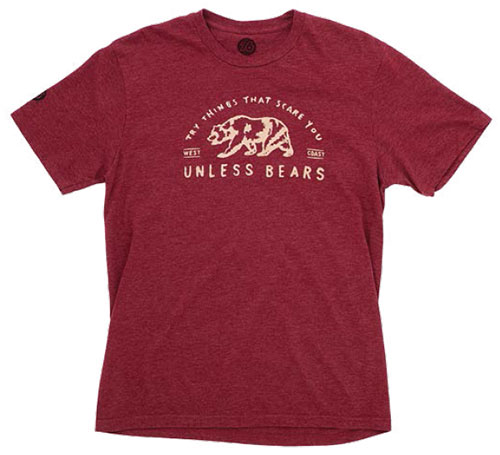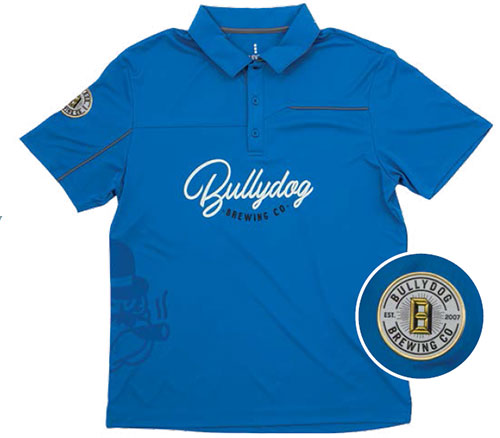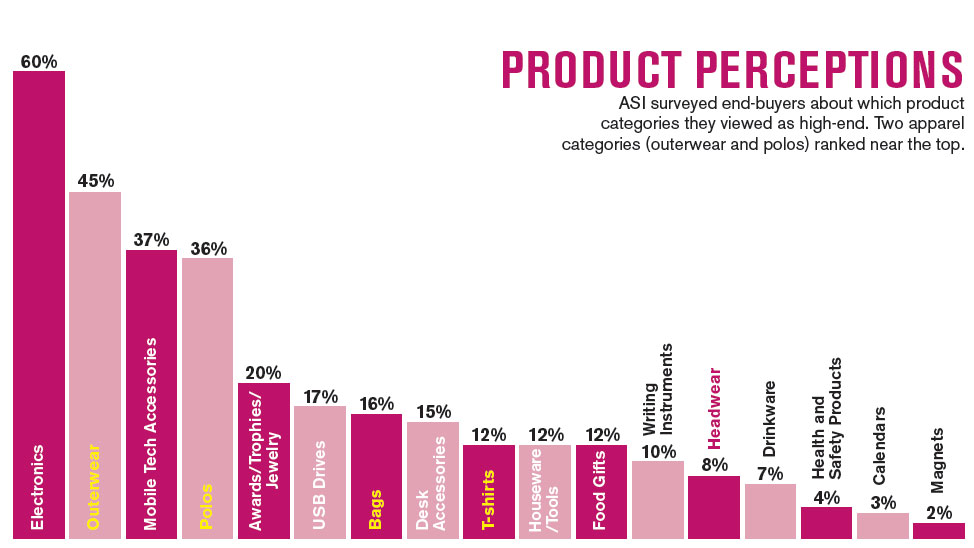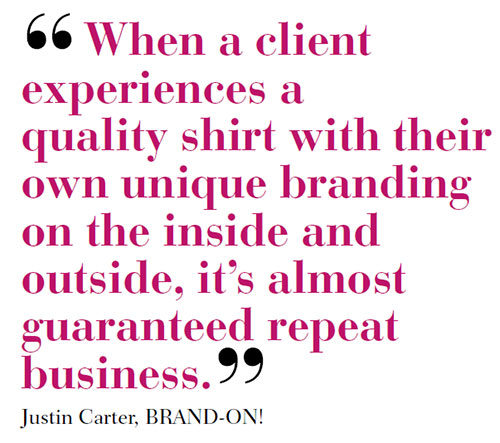June 13, 2018
Changing Perceptions Of Promo Apparel
End-buyers don’t have high opinions of branded garments. Here’s how you can change their minds.
Promotional apparel can be a powerful tool: a conversation starter, an identity symbol, a gift, a memory, a functional lifestyle piece.
However, apparel isn’t always held in such high regard, sabotaged by poor fabric quality, slipshod decorations or misguided promotions. And if a product intended to create brand awareness doesn’t make it out into the world, it’s falling short of its purpose – and its potential.
Don't Miss! Q&A: How Branding Raises Apparel Perceptions
When produced correctly, apparel is cherished as a premium possession. But ASI research reveals that isn’t happening often enough. A survey of end-buyers found that only 12% see T-shirts as a higher-end item. Just 8% feel the same about headwear. Polos fare better at 36% while outerwear did the best of all among apparel at 45%.
The data tells a simple fact: If end-buyers don’t view apparel as higher-end items, they won’t be likely to pay higher-end prices.
So, how can you reconnect buyers with the power of promotional apparel and earn the high margins you seek? You need to add value wherever possible – decoration, product, packaging, branding and more. Here are six ways to transform apparel.
1. Unique Decoration
Decoration plays perhaps the most important role in spreading a brand’s message because it literally displays that message. It’s no surprise that a branded garment has more perceived value than a blank one.
The best news? There’s currently a tremendous variety of decoration techniques to choose from – deboss, laser, sublimation and much more. Combine those techniques with the increasing use of nontraditional logo placement (such as a vertical layout or cross-seam print), and you have a unique design that will excite and surprise buyers.
“I have clients in the automotive industry who outfit their executives in our classic black Dade polo that’s debossed down the sleeve,” says Corey Cardinal, eastern regional sales manager at Trimark (asi/92121). “It’s the same price as a left-chest embroidered logo, but it’s incredibly sleek and appears expensive, which gives the distributor the chance to make a higher margin.”
T-Shirt Tycoon Solutions Inc. (asi/87000), a private-label clothing supplier in Garland, TX, offers 27 ways to decorate a T-shirt: lenticular print, sequins, vintage, jumbo, diamond-plate pattern, glow-in-the-dark and much more. These add-ons range in price from 50 cents to $4 each, and are as easy to request as checking a box upon ordering. “We could run a brand’s campaign for years and never overlap with the decoration techniques,” says Adam Walterscheid, president and CEO of T-Shirt Tycoon. “The goal is to give clients something they’ll wear around town, at shows and events, to generate impressions for the brand. This means it has to be decorated appropriately and be comfortable.”
 Private labeling, as demonstrated on this ringspun cotton/poly tee (A5026) will impress end-buyers. From T-Shirt Tycoon Solutions Inc. (asi/87000); ttycoon.com
Private labeling, as demonstrated on this ringspun cotton/poly tee (A5026) will impress end-buyers. From T-Shirt Tycoon Solutions Inc. (asi/87000); ttycoon.com
2. Retail Fabric
It’s basic, but undeniable: Great fabric helps make a great garment. Whether it’s ringspun cotton, a cotton/poly blend or a smooth tri-blend, customers prefer soft-hand fabrics for clothing they’re going to wear on a regular basis – which, of course, is the goal when generating return on investment.
Hanes Branded Printwear (asi/59528) recently launched its new Black Label collection, focusing on only ringspun fabric shirts with fashion fits. The supplier has grouped new and existing products (more than 20 styles) as part of a new marketing push to attract millennials and younger demographic groups. “There’s nothing out at retail now that’s not in the ringspun category,” says Rachel Newman, general manager of Hanes Branded Printwear. “This inspired us to add garments like the Modal Triblend and lighter-weight tees to help tell a more retail-inspired story with our fabrics. This line allows us to target different buyers who really know what’s going on at the consumer level.”
Fabric washes and treatments also offer the softness buyers truly value. T-Shirt Tycoon has its own proprietary Butter Wash treatment as an optional add-on, translated through a “Butter-ability” Rating: quarter-stick, three-quarter stick or full-stick softness, all priced equally. “Everyone wants a softer shirt, so we came up with a fun metaphor that made it easy for customers to choose their preference,” says Walterscheid. “The wash is done after all printing, so the inks have the same feel as the garment. It’s a complete lifestyle product that people will wear over and over.”
 Creative decoration and logo placement will raise buyer perceptions. This poly performance polo (TM16309) features screen printing, embroidery and laser etching. From Trimark (asi/92121); pcna.com/trimark
Creative decoration and logo placement will raise buyer perceptions. This poly performance polo (TM16309) features screen printing, embroidery and laser etching. From Trimark (asi/92121); pcna.com/trimark
3. Private Label
Brand names can have a significant effect on perceptions. Buyers who have the budget and desire will pay a premium for retail brand names offered in this industry – Under Armour, The North Face and hundreds of others.
But as ASI research shows, only about 30% of end-buyers rate brand names in apparel as very or extremely important. (By comparison, price, look and decoration quality all rank above 90%.) And if buyers aren’t motivated by a brand name, perhaps substituting their own corporate name and logo will entice them – in other words, private label.
Walterscheid knows the effect that private-label apparel can have on a client, and he only carries tagless blanks that allow for full customization. “When a client first sees their brand in a private label, it’s magical,” says Walterscheid. “It’s all their hard work, their story, their logo given this special platform – as opposed to competing with other generic brands that may decrease the value of the garment.”
Justin Carter, founder of Avon, CO-based BRAND-ON! (asi/145247), shows private-label options because he knows that once clients go down this road, they never turn back. “When a client experiences a quality shirt with their own unique branding on the inside and outside – and receives positive reactions from their end-users – it’s almost guaranteed repeat business,” Carter says. “We may simplify the design or change colors, but people don’t go backwards from there; they’re hooked on that higher value and they’ll pay extra for it.” Carter says adding private label is an average 10% increase in cost, with 30% being a reasonable markup to “still be really competitive.”
One big brand is following suit. Every product in the Hanes Black Label line has tearaway tags to enable clients to rebrand the product and manage their company’s brand intentionally and intimately. “Retail trends are moving to our industry much faster than they used to, and the ability to fully brand a product without competing logos is essential,” says Newman. “We’re estimating at least 15-20% of garments in our fashion-forward ringspun category will be private labeled.”
4. Creative Packaging
How a customer receives a product is just as important as what product they receive. “Presentation is everything, and it requires a lot of homework to execute properly,” says Janie Gaunce, president and CEO of Lenexa, KS-based Grapevine Designs (asi/212829), which specializes in high-end kitted projects and creative packaging. “Figure out how the products are being distributed and to whom they’re being given – then work backwards.”
If the client is mailing the products, think about adding value with colored tissue paper or a branded box. If it’s an event and the end-user is visiting a booth to choose their items, brand the display to align with the theme and handle the necessary logistics. “We did a trade show where the client ordered 3,800 garments to give out, so my first question was about the waste disposal system – what were they going to do with 3,800 boxes and how were they going to restock the items in an orderly fashion once they ran low?” Gaunce says. “You have to think about these details so the entire execution appears clean and thoughtful. This type of service is priceless.”
 The new Black Label collection features 20 fashion-forward styles, including this 100% ringspun cotton tee, and tearaway labels. From Hanes Branded Printwear (asi/59528); haneslocator.com
The new Black Label collection features 20 fashion-forward styles, including this 100% ringspun cotton tee, and tearaway labels. From Hanes Branded Printwear (asi/59528); haneslocator.com
Simple elements such as hangtags and polybagging will instantly raise perceptions, but it’s the truly creative packaging that will stand out. Shockwaves Promotional Apparel (asi/87144) in Arlington Heights, IL, has no shortage of fun packaging ideas. The contract decorator sublimated shirts with an all-over pizza print, placed them in printed pizza boxes and delivered them to prospects as a self-promo, which led to several orders and a lot of buzz among the recipients. They’ve also executed a similar project using Dunkin’ Donuts and Krispy Kreme boxes, stuffing them with sublimated shirts that passed for a dozen donuts at first glance. “Packaging and presentation add emotion to the exchange,” says Greg Gaardbo, CEO and creative director. “We go far beyond a commercial decorator at this point; we become creative incubators.”
 Click here for a larger image of the above graph.
Click here for a larger image of the above graph.
5. Samples
It’s not always easy for customers to imagine their messaging on certain products, not to mention visualize how the whole campaign might play out. Reps can utilize their resources, both within their companies and those offered through supplier partners, to help clients experience the possibilities through virtuals, design boards, spec samples and sales kits.
“Samples are my biggest sales tool when it comes to apparel,” says Marcus Zielinski, sales manager at Cuyahoga Falls, OH-based Redfish Promotions (asi/254159). “I’ve been selling much more women’s apparel to corporate clients the past few years, and the cut and feel of the garment is so important. You have to touch them, to try them on, to show them to your team members – there’s no other way to get the full experience.”
Zielinski recently went on a sales call at a high-end auto dealer and his rep from Cutter and Buck (asi/47965) joined him with a full rack of samples and ideas to fulfill the client’s apparel needs. “Having input from a supplier expert made the client feel like they were getting the royal treatment, and seeing all of their options in one place helped close the sale,” says Zielinski. “It pays to have supplier partners willing to share resources to help you win a client.”
Other full-service suppliers offer sales or pre-production kits complete with decorated items to generate ideas and highlight the client’s options. Virtual samples can also help move the process along and upsell unique techniques and messaging options. “We have a designated team that creates INSPIRE cards for our distributors: sales cards that take one of our garments and show tangible ideas for what you can do with that piece,” says Cardinal of Trimark. “Oftentimes, the client needs to see options first, and once they choose a few ideas they like, you can move into the sample or spec phase.”

In many cases, apparel sells itself, as long as you get it in front of the customer. “If I bring a ringspun blend and a traditional T-shirt with plastisol ink on a sales call, there’s really no question about which they’ll go for,” says Carter. “Once they see the difference in quality, clients are willing to make the investment to get the end-user to wear it.”
6. Inventive Ideas
Many promotional companies fear the competition of web-based businesses, but nothing compares to a creative partner who understands a client’s brand, listens to their goals and designs products that can’t be found anywhere else. Merely selling product enables the client to shop around for the same item at a cheaper price; selling a combination of garments, ideas and strategies that fit the occasion ensures your client can’t find a better deal elsewhere – and they probably won’t even look.
Shockwaves specializes in one-of-a-kind multimedia apparel designs. “Don’t be afraid to combine techniques and experiment with different inks, prints and fabrics,” Gaardbo says. “Invest in machinery and technology that allows you to surpass your competition’s capabilities, and charge for your intellectual property. If you’re the only kid on the block doing it, they’re not going to find a lower price elsewhere.”
At Trimark, reps aim to provide “Google-proof” service so they don’t have to compete on price. “Distributors can no longer act as just sourcing specialists because now the internet can do that for clients,” Cardinal says. “However, any time you do something innovative or creative, you become unsearchable. A client can’t find another deboss on the left chest with transfer over the shoulder and embroidery on the hip – so you can name your price.”
A New Message
A new product isn’t always necessary to reach buyers or raise the perceptions of current ones. Smart marketing allows any company to reframe the message and get the desired effect it seeks.
Hanes Branded Printwear (asi/59528) recently decided to revamp its marketing strategy with the primary goal of targeting younger, fashion-conscious buyers … all without completely uprooting its product line. The apparel company didn’t have to add many products. Instead, it focused on its go-to-market strategy, telling a different story about its products, which transformed the way consumers receive the brand.
“We’ve always been very sub-brand focused, and our products were basics-driven and family-oriented,” says Rachel Newman, general manager of Hanes Branded Printwear. “In order to compete, we had to talk to the target consumer – the younger generations – in more of an inspirational way, which meant new messaging, new content and a completely new marketing strategy.”
Hanes launched Black Label, and with it, a microsite separate from the general Hanes website, where consumers can find an edgy, fashion-forward mix of products. The Black Label logo is simple, sleek and sophisticated, as is any branding surrounding the line. The supplier reinvented its trade show displays, aired a video on Vimeo that included a sexy, high-end fashion photo shoot, and sent samples to wholesalers in custom packaging: black boxes with red interiors.
“We are now telling a cohesive story to our customers who could turn around and sell the product to their customers, and the messaging will trickle down,” says Newman. “We’re working on connecting with consumers through social media and other channels where we meet them on their own turf and communicate in ways they prefer. It’s a whole new ball game.”
Andy Vantrease is a contributing writer for Wearables.

Product Hub
Find the latest in quality products, must-know trends and fresh ideas for upcoming end-buyer campaigns.